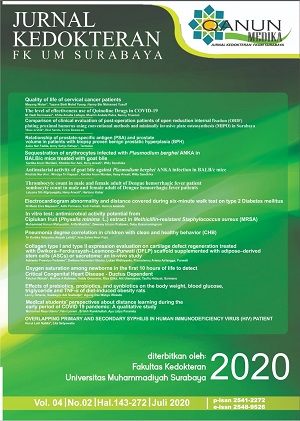In Vitro Test: Antimicrobial Activity Potential From Ciplukan Fruit (Physalis minima L.) Extract in Methicillin-resistant Staphylococcus aureus (MRSA)
Abstract
Abstract
Â
In Indonesia, in 2006, the prevalence of infections due to MRSA was 23.5%. Physalis minima L. plants are known to have antimicrobial activity because they contain compounds withaferin A, which can induce programmed cell death. This research was to determine the minimum inhibitory concentration (MIC) and minimum bactericidal concentration (MBC) of Ciplukan (Physalis minima L.) extract in Methicillin-resistant Staphylococcus aureus (MRSA) bacteria. Dilution test with Mueller-Hinton broth medium used for measuring the minimum inhibitory concentration (MIC). Ciplukan fruit extract was dissolved in distilled water, and poured into a test tube with a certain concentration (0.9 g/mL (90%); 0.3 g/mL (45%); 0.15 g/mL (22.5%); 0.075 g/mL (11.25%) and 0.0375 g/mL (5.625%). After being incubated for 24 hours, the bacteria in the test tube were plated on nutrient agar plates to determine the MBC. The MIC cannot be determined, because the medium in the dilution test tube is disturbed by the color of the extract so that turbidity cannot be observed. From the observations of the minimum bactericidal concentration, MBC of the Ciplukan (Physalis minima  L.) fruit extract against MRSA was in the P1 tube or equivalent to 0.9 g / ml (90%).
Keywords            : Physalis minima L., Antimicrobial, Ciplukan, Methicillin-resistant Staphylococcus aureus, Withaferin A
Correspondence  : arifa-m@fk.unair.ac.id
Full text article
References
Chen, C. and Huang, Y. (2014). New epidemiology of Staphylococcus aureus Infection in Asia. Clinical Microbiology and Infection, 20 (7) 605-623
Chotani L. D. and Vaghasiya H.U. (2012). A phyto-pharmacological overview on Physalis minima Linn. Indian Journal of Natural Products and Resources, 3(4), 477-482
Cushnie, T., Cushnie, B. and Lamb, A. (2014). Alkaloids: An overview of their antibacterial, antibiotic-enhancing and antivirulence activities. International Journal of Antimicrobial Agents, 44(5), 377-386
Haddadin, A. (2002). Methicillin resistant Staphylococcus aureus (MRSA) in the intensive care unit. Postgraduate Medical Journal. 78 (921), 385-392
Hadi, Usman, Kuntaman, Mariyatul Qiptiyah, and Hari Paraton. Problem of Antibiotic Use and Antimicrobial Resistance in Indonesia : Are We Really Making Progress?. 2013. Indonesian Journal of Tropical and Infectious Disease, 4(4),7
Jansen, W., Beitsma, M., Koeman, C., van Wamel, W., Verhoef, J. and Fluit, A. (2006). Novel Mobile Variants of Staphylococcal Cassette Chromosome mec in Staphylococcus aureus. Antimicrobial Agents and Chemotherapy, 50(6), 2072-2078
Jing Tang, Jiali Hu, and Lei Kang. (2015). The use of vancomycin in the treatment of adult patients with methicillin-resistant Staphylococcus aureus (MRSA) infection: a survey in a tertiary hospital in China. International Journal of Clinical and Experimental Medicine. 8(10), 19436-19441
Kannan, N.D. and Kulandaivelu, G. (2007). Novel method to isolate Withaferin A from Withania somnifera roots and its bioactivity. Allelopathy Journal, 20, 213-220
Lowy, F. (1998). Staphylococcus aureus Infections. New England Journal of Medicine, 339(8), 520-532
MartÃnez, Y., Li, X., Liu, G., Bin, P., Yan, W., and Más, D. et al. (2017). The role of methionine on metabolism, oxidative stress, and diseases. Amino Acids, 49 (12), 2091-2098
Memmi, G., Filipe, S., Pinho, M., Fu, Z. and Cheung, A. (2008). Staphylococcus aureus PBP4 Is Essential for -Lactam Resistance in Community-Acquired Methicillin-Resistant Strains. Antimicrobial Agents and Chemotherapy, 52(11), 3955-3966
Pradana, E.W. (2014). Uji Efektivitas Ekstrak Etanol Daun Ceplukan (Physalis minima L.) Terhadap Streptococcus mutans secara in vitro. Sarjana thesis. Malang : Universitas Brawijaya.
Raharjoyo, L. (2007). Profil Kromatogram dan Aktivitas Antibakteri Ekstrak Etanol Rimpang Bengle (Zingiber cassumunar roxb.) Terhadap Bakteri Escherichia coli In Vitro. Skripsi. Semarang : Universitas Diponegoro
Ranuwibawa, M.S. (2012). Efek Antimikroba Ekstrak Daun
Ciplukan (Physalis minima ) Terhadap Pertumbuhan Bakteri Salmonella Typhi Secara In Vitro. Sarjana thesis. Malang : Universitas Brawijaya
Rao, K. and Venkatachalam, S. (2000). Inhibition of dihydrofolate reductase and cell growth activity by the phenanthroindolizidine alkaloids pergularinine and tylophorinidine: the in vitro cytotoxicity of these plant alkaloids and their potential as antimicrobial and anticancer agents. Toxicology in Vitro. vol 14(1) p. 53-59
Rasigade, J. and Vandenesch, F. (2014). Staphylococcus aureus: A pathogen with still unresolved issues. Infection, Genetics and Evolution, 21, 510-514
Rayner, C. and Munckhof, W. (2005). Antibiotics currently used in the treatment of infections caused by Staphylococcus aureus. Internal Medicine Journal, 35(2), 3-16
Sail, V. and Hadden, K. Notch Pathway Modulators as Anticancer Chemotherapeutics. (2012). Annual Reports in Medicinal Chemistry, 47, 267-278
Shariff, N., Sudharsana M.S., Umesha, S., and Hariprased P. (2006). Antimicrobial activity of Rauvolfia tetraphylla and Physalis minima leaf and callus extracts. African Journal of Biotechnology, 5(10), 946-950
Sulistyoningsih. (2010). Uji Kepekaan Beberapa Sediaan Antiseptik Terhadap Bakteri Staphylococcus aureus dan Staphylococcus aureus Resisten Metisilin (MRSA). Jatinanggor : Fakultas Farmasi Universitas Padjajaran.
Authors

Qanun Medika by FK UM Surabaya is liscence under Lisensi Creative Commons Atribusi 4.0 Internasional.

